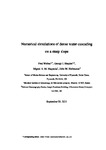Numerical simulations of dense water cascading on a steep slope
| dc.contributor.author | Wobus, F | |
| dc.contributor.author | Shapiro, Georgy | |
| dc.contributor.author | Maqueda, MAM | |
| dc.contributor.author | Huthnance, JM | |
| dc.date.accessioned | 2013-10-28T17:26:46Z | |
| dc.date.available | 2013-10-28T17:26:46Z | |
| dc.date.issued | 2012-01-03 | |
| dc.identifier.issn | 0022-2402 | |
| dc.identifier.issn | 1543-9542 | |
| dc.identifier.uri | http://hdl.handle.net/10026.1/2422 | |
| dc.description.abstract |
The sinking of dense shelfwaters down the continental slope (or “cascading”) contributes to oceanic water mass formation and carbon cycling. Cascading over steep bottom topography is studied here in numerical experiments using POLCOMS, a 3-D ocean circulation model using a terrain-following s-coordinate system. The model setup is based on a laboratory experiment of a continuous dense water flow from a central source on a conical slope in a rotating tank. The governing parameters of the experiments are the density difference between plume and ambient water, the flow rate, the speed of rotation and (in the model) diffusivity and viscosity. The descent of the dense flow as characterized by the length of the plume as a function of time is studied for a range of parameters. Very good agreement between the model and the laboratory results is shown in dimensional and nondimensional variables. It is confirmed that a hydrostatic model is capable of reproducing the essential physics of cascading on a very steep slope if the model correctly resolves velocity veering in the bottom boundary layer. Experiments changing the height of the bottom Ekman layer (by changing viscosity) and modifying the plume from a 2-layer system to a stratified regime (by enhancing diapycnal diffusion) confirm previous theories, demonstrate their limitations and offer new insights into the dynamics of cascading outside of the controlled laboratory conditions. | |
| dc.format.extent | 391-415 | |
| dc.language | en | |
| dc.language.iso | en | |
| dc.publisher | Yale University | |
| dc.title | Numerical simulations of dense water cascading on a steep slope | |
| dc.type | journal-article | |
| dc.type | Article | |
| plymouth.author-url | http://www.plymouth.ac.uk/staff/fwobus | |
| plymouth.issue | 2 | |
| plymouth.volume | 69 | |
| plymouth.publisher-url | http://www.yale.edu/jmr/ | |
| plymouth.publication-status | Published | |
| plymouth.journal | Journal of Marine Research | |
| dc.identifier.doi | 10.1357/002224011798765268 | |
| plymouth.organisational-group | /Plymouth | |
| plymouth.organisational-group | /Plymouth/Faculty of Science and Engineering | |
| plymouth.organisational-group | /Plymouth/Faculty of Science and Engineering/School of Biological and Marine Sciences | |
| plymouth.organisational-group | /Plymouth/PRIMaRE Publications | |
| plymouth.organisational-group | /Plymouth/REF 2021 Researchers by UoA | |
| plymouth.organisational-group | /Plymouth/REF 2021 Researchers by UoA/UoA07 Earth Systems and Environmental Sciences | |
| plymouth.organisational-group | /Plymouth/Research Groups | |
| plymouth.organisational-group | /Plymouth/Research Groups/Marine Institute | |
| plymouth.organisational-group | /Plymouth/Users by role | |
| plymouth.organisational-group | /Plymouth/Users by role/Academics | |
| plymouth.organisational-group | /Plymouth/Users by role/Researchers in ResearchFish submission | |
| dc.identifier.eissn | 1543-9542 | |
| dc.rights.embargoperiod | Not known | |
| rioxxterms.versionofrecord | 10.1357/002224011798765268 | |
| rioxxterms.licenseref.uri | http://www.rioxx.net/licenses/all-rights-reserved | |
| rioxxterms.type | Journal Article/Review |


